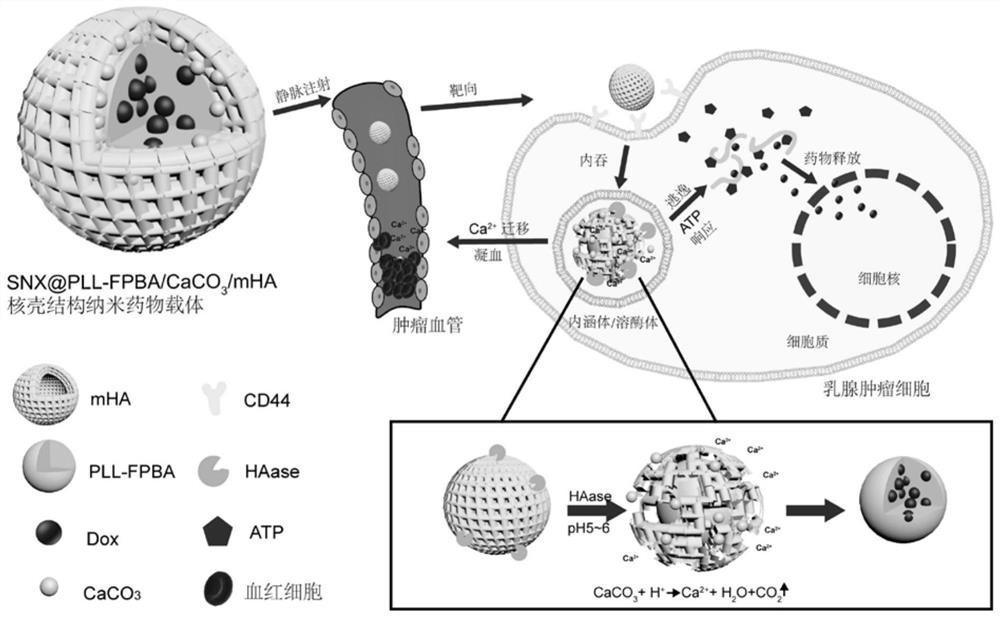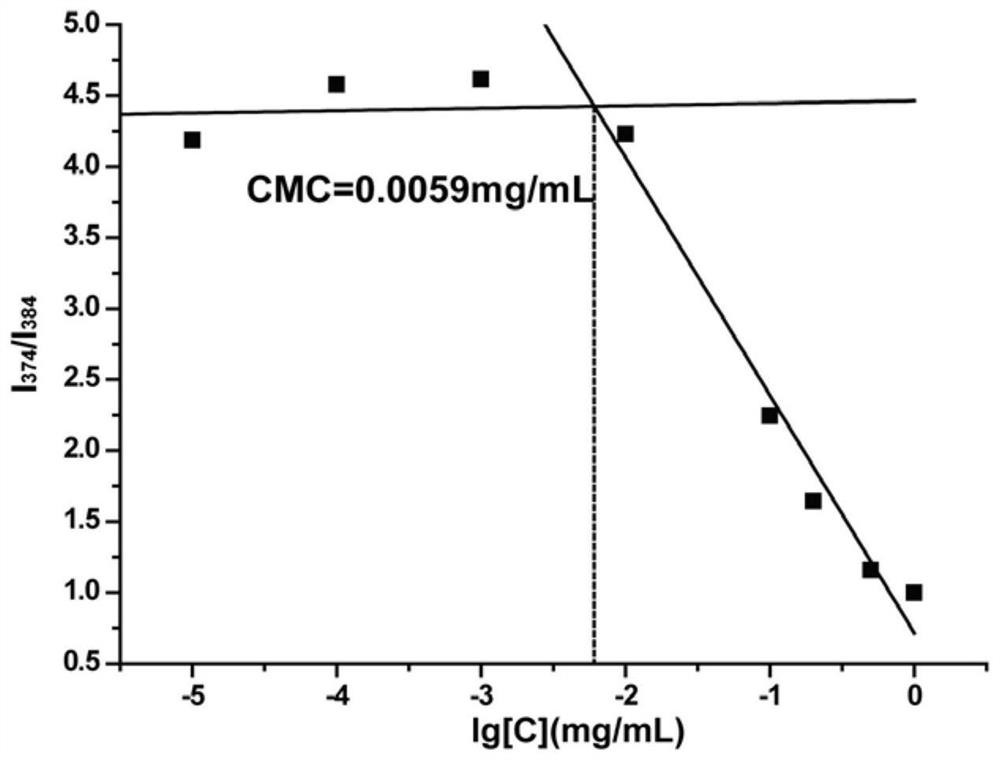Nanoparticles for promoting tumor coagulation and enzyme/ATP dual responsive drug release, and preparation method and application of nanoparticles
A nanoparticle, drug-loaded nanotechnology, applied in the direction of anti-tumor drugs, pharmaceutical formulations, medical preparations of non-active ingredients, etc.
- Summary
- Abstract
- Description
- Claims
- Application Information
AI Technical Summary
Problems solved by technology
Method used
Image
Examples
Embodiment 1
[0084] (1) Preparation of core layer PLL-FPBA drug-loaded nanoparticles
[0085] 100mgε-polylysine hydrochloride (PLL·HCl, weight average molecular weight 5×10 3 g / mol) was dissolved in 20mL deionized water, 44mg FPBA (3-fluoro-4-carboxyphenylboronic acid) was dissolved in 8.8mL deionized water, after the two solutions were mixed (the molar ratio of PLL and FPBA was 1:10), Add 560 mg of activator 4-(4,6 dimethoxytriazin-2-yl)-4-methylmorpholine hydrochloride (DMTMM, molar ratio DMTMM:PLL·HCl=3:1), stir at room temperature After 24 hours of reaction, the solution was transferred to a dialysis bag (MWCO: 2kDa) and dialyzed with deionized water for 7 days, and the amphiphilic polymer PLL-FPBA was obtained after freeze-drying. PLL-FPBA 1 HNMR spectrum as figure 2 As shown, the substitution degree of FPBA is 36.7%. The critical micelle concentration CMC value of PLL-FPBA measured by fluorescence spectroscopy was 5.9 μg / mL, as image 3 shown.
[0086] Dissolve 20mg of PLL-FPB...
Embodiment 2
[0100] (1) Preparation of core layer PLL-FPBA drug-loaded nanoparticles
[0101] 100mgε-polylysine hydrochloride (PLL·HCl, weight average molecular weight 1×10 4 g / mol) was dissolved in 20mL deionized water, 22mg FPBA was dissolved in 4.4mL deionized water, and the two solutions were mixed (the molar ratio of PLL and FPBA was 1:5). Add 560 mg of activator 4-(4,6 dimethoxytriazin-2-yl)-4-methylmorpholine hydrochloride (DMTMM, molar ratio DMTMM:PLL·HCl=3:1), stir at room temperature After 24 hours of reaction, the solution was transferred to a dialysis bag (MWCO: 2kDa) and dialyzed with deionized water for 7 days, and the amphiphilic polymer PLL-FPBA was obtained after freeze-drying. 1 H NMR test showed that the substitution degree of FPBA was 10%. The critical micelle concentration CMC value of PLL-FPBA measured by fluorescence spectroscopy was 8.0μg / mL.
[0102] Dissolve 20mg of PLL-FPBA in 20mL DMSO / HCl (volume ratio, 0.1M HCl / DMSO=1:4), stir to dissolve and add 5mg of ant...
Embodiment 3
[0110] (1) Preparation of core layer PLL-FPBA drug-loaded nanoparticles
[0111] 100mgε-polylysine hydrochloride (PLL·HCl, weight average molecular weight 3×10 3 g / mol) was dissolved in 20 mL of deionized water, 88 mg of FPBA was dissolved in 17.6 mL of deionized water, after the two solutions were mixed (the molar ratio of PLL and FPBA was 1:20), 560 mg of activator 4-(4,6 di Methoxytriazin-2-yl)-4-methylmorpholine hydrochloride (DMTMM, molar ratio DMTMM:PLL·HCl=3:1), stirred and reacted at room temperature for 24h, after the reaction was completed, the solution was transferred to dialysis The bag (MWCO: 2kDa) was dialyzed with deionized water for 7 days, and the amphiphilic polymer PLL-FPBA was obtained after freeze-drying. 1 H NMR test showed that the substitution degree of FPBA was 50%. The critical micelle concentration CMC value of PLL-FPBA measured by fluorescence spectroscopy was 3.3μg / mL.
[0112] Dissolve 20mg of PLL-FPBA in 20mL DMSO / HCl (volume ratio, 0.1M HCl / D...
PUM
| Property | Measurement | Unit |
|---|---|---|
| particle diameter | aaaaa | aaaaa |
| particle diameter | aaaaa | aaaaa |
| concentration | aaaaa | aaaaa |
Abstract
Description
Claims
Application Information
 Login to View More
Login to View More - R&D
- Intellectual Property
- Life Sciences
- Materials
- Tech Scout
- Unparalleled Data Quality
- Higher Quality Content
- 60% Fewer Hallucinations
Browse by: Latest US Patents, China's latest patents, Technical Efficacy Thesaurus, Application Domain, Technology Topic, Popular Technical Reports.
© 2025 PatSnap. All rights reserved.Legal|Privacy policy|Modern Slavery Act Transparency Statement|Sitemap|About US| Contact US: help@patsnap.com



